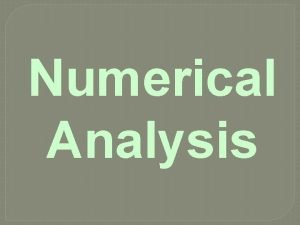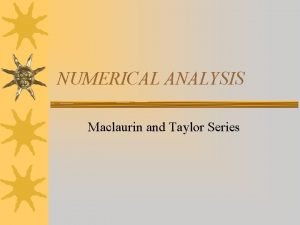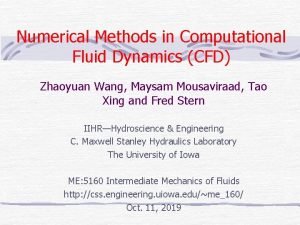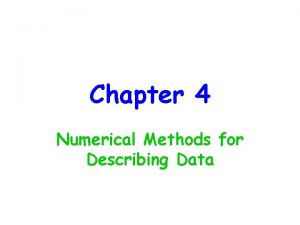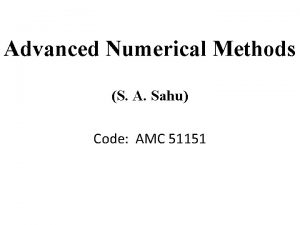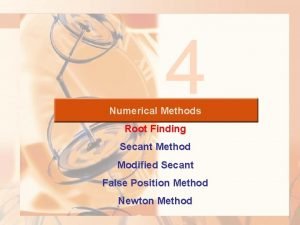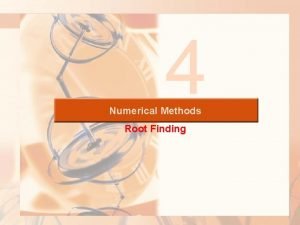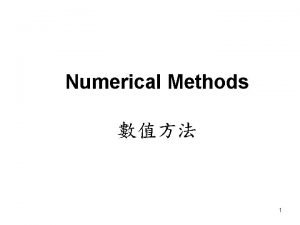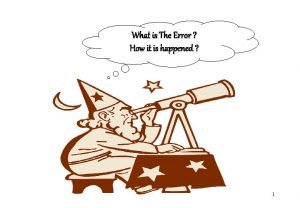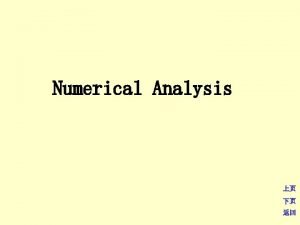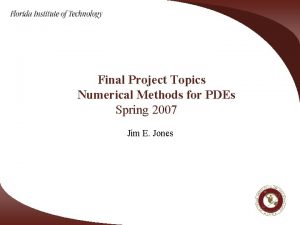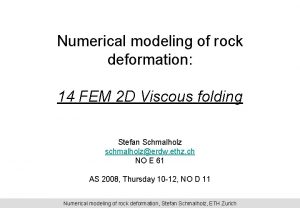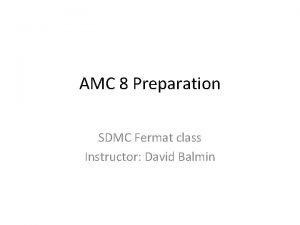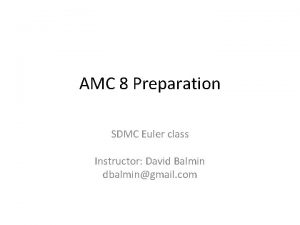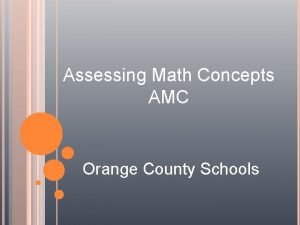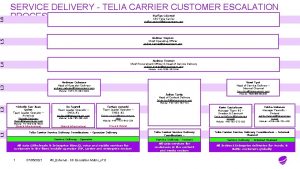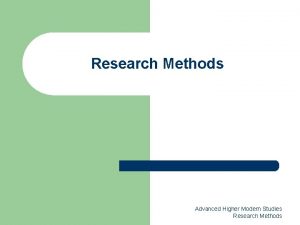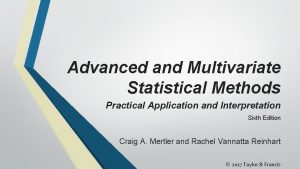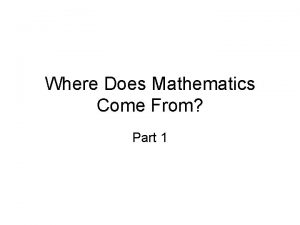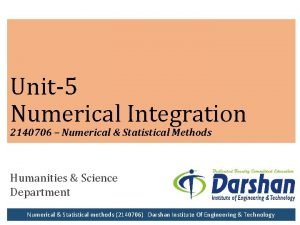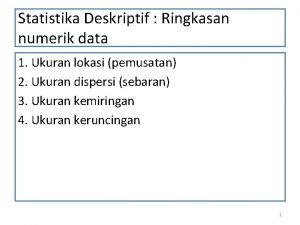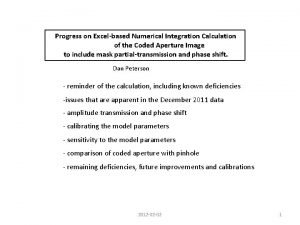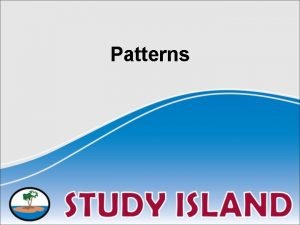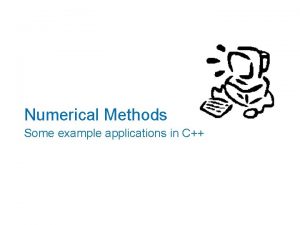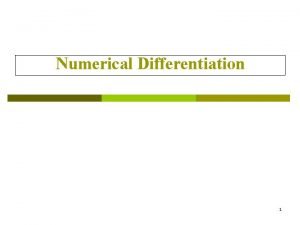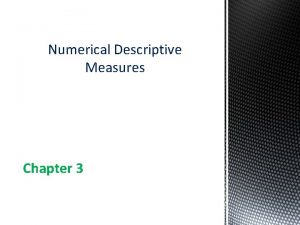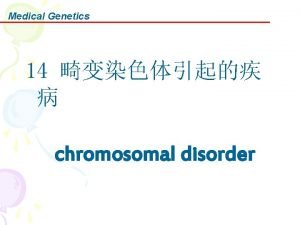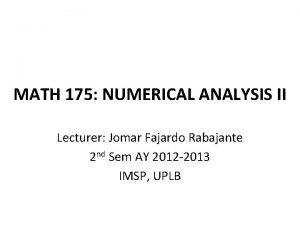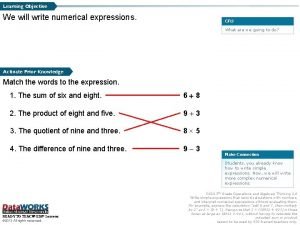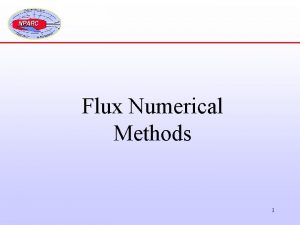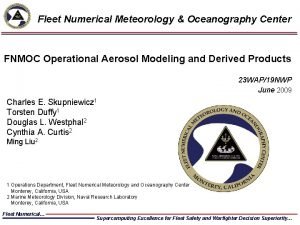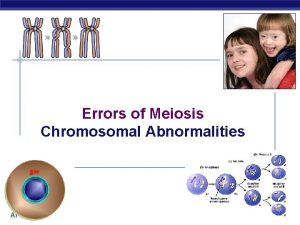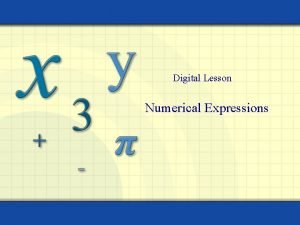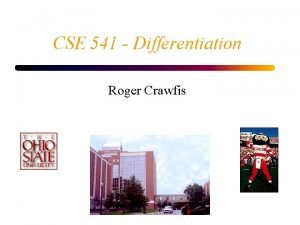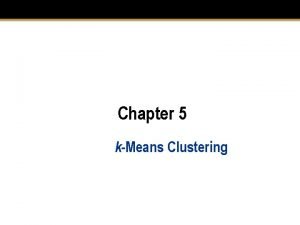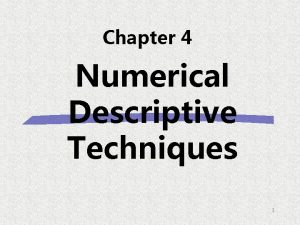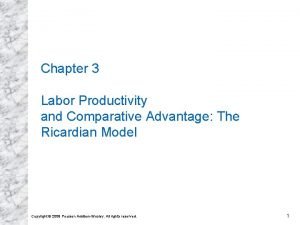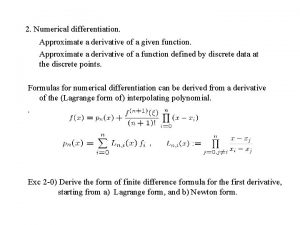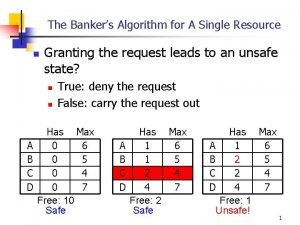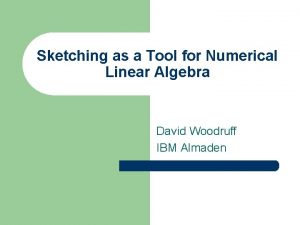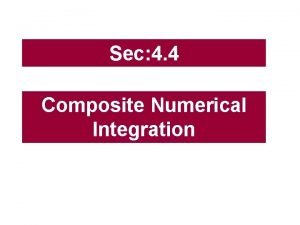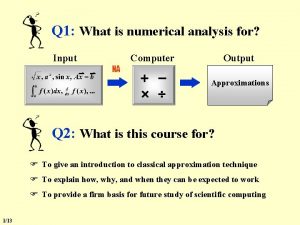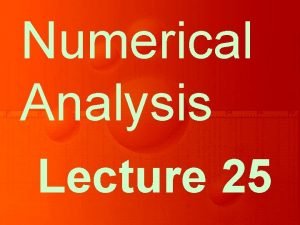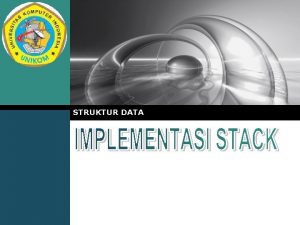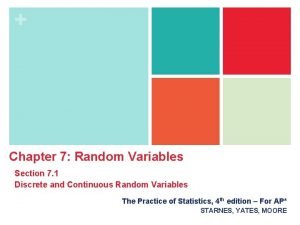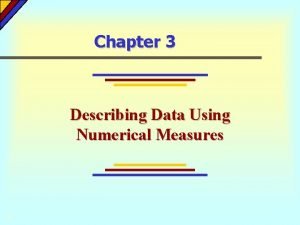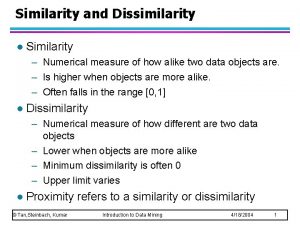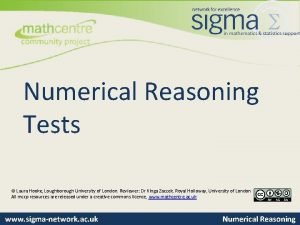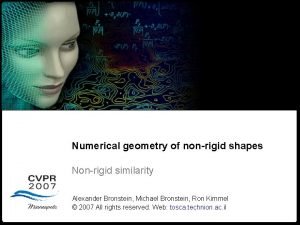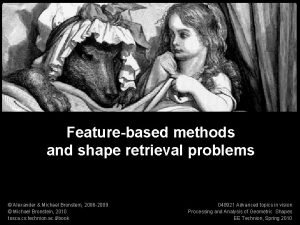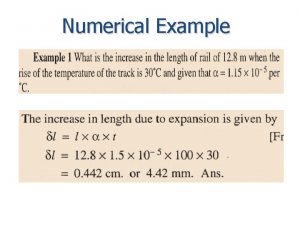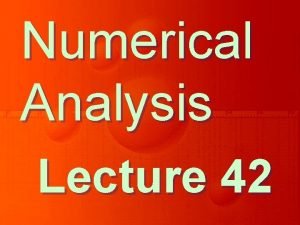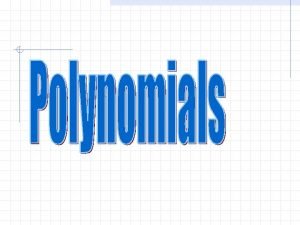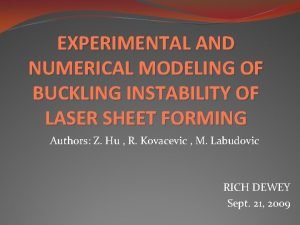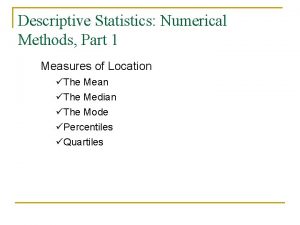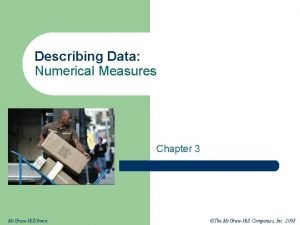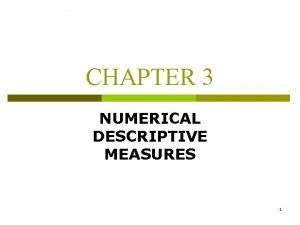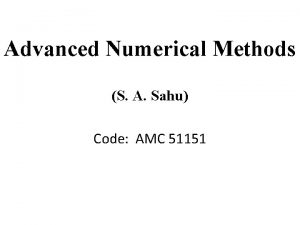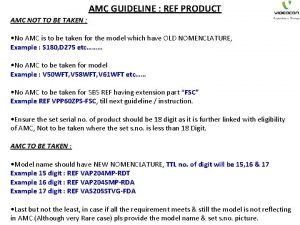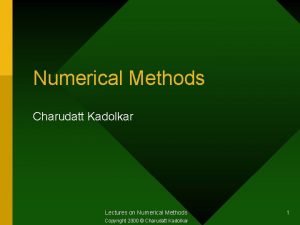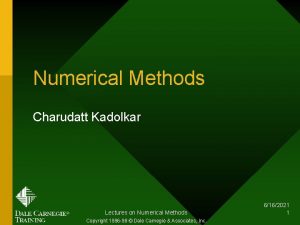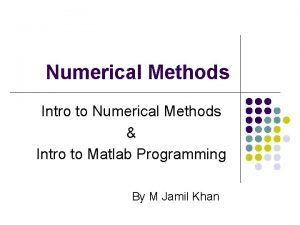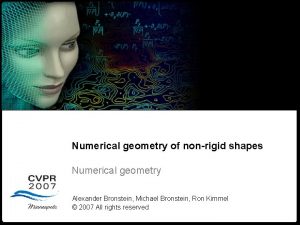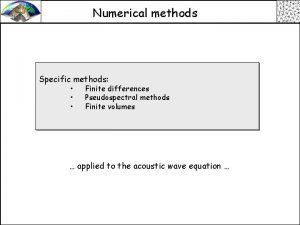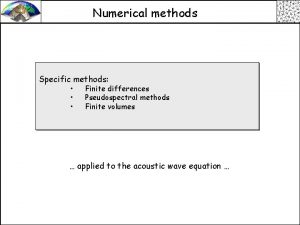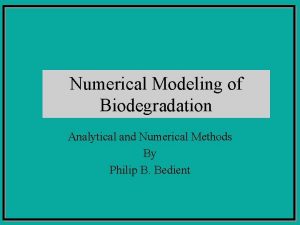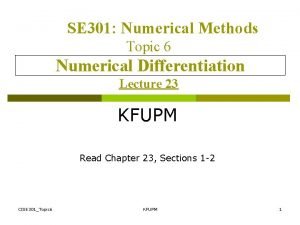Advanced Numerical Methods S A Sahu Code AMC






















































































![• Stirling Formula (Derivation) [Mean of Gauss Fwd. & Gauss Bkwd] • Eq. • Stirling Formula (Derivation) [Mean of Gauss Fwd. & Gauss Bkwd] • Eq.](https://slidetodoc.com/presentation_image_h/ab42ee7196876ee49427837c70eafb81/image-87.jpg)















- Slides: 102

Advanced Numerical Methods (S. A. Sahu) Code: AMC 51151

Syllabus We can divide our syllabus in following four major sections: 1. Method of solution of system of equations Solution of Non-linear Simultaneous Equations (Newton-Raphson Method) Tridiagonal system of equations (Thomas algorithm)

2. Numerical Integration Evaluation of Double & Triple Integrals (a) Constant Limit Simpson’s Rule (b) Variable Limit & Trapezoidal Rule

3. Methods of Interpolation Ø Newton’s F/W and B/W formula Ø Gauss’s F/W and B/W formula Ø Bessel’s Formula Ø Stirling Formula Ø Lagrange’s Interpolation Formula Ø Newton’s Divided Difference Formula

4. Numerical Solution of Differential Equations O. D. E. • First Order & Higher Ordinary Diffe. Eqs. • Initial Value & Boundary Value Problems P. D. E. • Laplace & Poisson Equations • Heat Conduction • Wave Equations

Solution of Non-linear Simultaneous Equations (Newton-Raphson Method)

This Method is extension of N-R Method for Non-Linear Equation • Method for Simultaneous equations: Suppose we are given the following Simultaneous equations …(1) Why simultaneous. . ?

We consider that be the first approximation And be the real roots It means, we must have : …. (2)

Now we expand the relation, we had in eq. (2) Using Taylor Series Expansion (3) (similarly for ) Now since h and k are very small, we can neglect the terms containing (or )and higher order terms…

• Now, eq. (2), eq. (3) and assumption suggests . . (4 a) . . (4 b)

• Or simply: … 5(a) . . 5(b) Let us say

Cramer’s Rule for or the solution of a system of linear equation

• We have from Eqs. 5(a) & 5(b) Or in matrix form

Now let us call And hence we can have (from Cramer’s rule)

• This gives the next approximation, as Using these values we can proceed further for next approximation (better value) This completes the method.

• Solve the given simultaneous equations (up to two iterations)

Q. 2

Solution of Q. 2


• And hence we have the second approximation as • We repeat the process for next approximation

Tridiagonal system of equations (Thomas algorithm)

• In applications, many times we can have system of equations which gives a coefficient matrix of special structure, majority of zeros. Sparse matrices [Upper Triangular & Lower Triangular Matrices] What, If we have a matrix such that except the principal diagonal and its upper and lower diagonal, all the elements are zero…. ? ? ?

Such a matrix is called TRIDIAGONAL MATRIX

Something which looks like…….

Tridiagonal Systems: • The non-zero elements are in the main diagonal, super diagonal and subdiagonal. • aij=0 if |i-j| > 1 CISE 301_Topic 3 25

Mathematically…. • An n×n matrix A is called a tridiagonal matrix if whenever • The system of equations which gives rise to a tridiagonal coefficient matrix is called …. . Tridiagonal System of Equations

A tridiagonal system for n unknowns may be written as …(1) B. V. P. with second order ODE, Heat conduction equations…. Generate equations like (1)


Which in matrix form can be written as

• Thomas algorithm (named after L. H. Thomas), is a simplified form of Gauss elimination method • Suppose we have a system like And we have to find all the unknowns…

Then Thomas Algo. Gives the values of unknown in the order last to first. . It means first we shall get and then by back substitution, we will get

Where and

Q. 1 Solve the following system of equations

In matrix form CISE 301_Topic 3 34


Section: 2 Finite Difference Interpolation Numerical Integration

Finite Differences Let we have . . (1) which is tabulated for equally spaced values. .

And returns the following values It means

Then we can define the following Differences • Forward Difference DELTA • Backward Difference Nabla • Central Difference delta (lower case)

• Forward Difference First Forward Difference We define the FORWARD DIFFERENCE OPERATOR, denoted by as The expression gives the FIRST FORWARD DIFFERENCE of and the operator is called the FIRST FORWARD DIFFERENCE OPERATOR.

• Notation (First Forward Differences)

Second Forward Differences are given by

• And hence in general the pth Forward Diff. . . (2)

• Forward Difference Table

• Forward Diff. Terms

• Backward differences are defined and denoted by following

Following the concept of Forward Diff. Make a table for Backward Difference up to 5 th Difference

• Central Differences • The central Diff. operator is defined by the following relation Define second third and other central differences And make a central diff. table

• Write the forward Diff. table if…

• Other operators Shift Operator E Average Operator

Shift Operator is the operation of increasing of argument x by h and hence defined by The inverse shift operator is defined by

We have defined the following Differences • Forward Difference DELTA • Backward Difference Nabla • Central Difference delta • Shift Operator E • Average Operator

Relations among the operators

• Proof of (i)

Interpolation Suppose we have following values for y=f(x)

• Interpolation is the technique of estimating the value of a function for any intermediate value of the independent variable • The process of computing the value of the function outside the range is called Extrapolation

Interpolation Equal spaced Unequal Differences Forward Interpolation Newton’s Divided Diff. (Newton’s Fwd. Int. ) Backward Interpolation Lagrange’s Interpolation (Newton’s Bwd. Int. ) Central Diff. Interpolation • Gauss Forward • Gauss Backward • Stirling Formula • Bessel’s Formula • Everett’s Formula

Newton’s Forward Interpolation Suppose the function is tabulated for equally spaced values. . And it takes the following values

• Suppose we have to calculate f(x) at x=x 0+ph (p is any real number), then we have Now we expand the term by Binomial theorem

The above blue colored equation (1) is Newton’s Forward Interpolation Formula Because it contains y 0 and forward differences of y 0

Example Estimate f (3. 17)from the data using Newton Forward Interpolation. x: 3. 1 f(x): 0 3. 2 0. 6 3. 3 1. 0 3. 4 1. 2 61 3. 5 1. 3

Solution 62

Solution 63

Newton’s Backward Interpolation Suppose the function is tabulated for equally spaced values. . And it takes the following values

• Suppose we have to calculate f(x) at x=xn+ph (p is any real number, may be -ve), then we have Now we expand the term by Binomial theorem

NEWTON GREGORY BACKWARD INTERPOLATION FORMULA 66

Example Estimate f(42) from the following data using newton backward interpolation. x: 20 25 30 35 40 45 f(x): 354 332 291 260 231 204 67

Solution Here xn = 45, h = 5, x = 42 and p = - 0. 6 68

Solution 69

Central Difference Formula • Gauss Forward • Gauss Backward • Stirling Formula • Bessel’s Formula • Everett’s Formula


• If y=f(x) is any function, which takes values and returns corresponding values • Then the difference table can be written as

Central Difference table Table-1

1. GAUSS FORWARD INTERPOLATION FORMULA OR …. . (A) 74

Derivation of Gauss Fwd. Int. Formula We have Newton’s Forward Int. Formula We have following relations (from table)


• Note: (1) Gauss forward formula contains odd differences just below the central line and even differences on the central line (2) Formula is useful to interpolate the value of y for 0<p<1, measured forwardly

Example Find f(30) from the following table values using Gauss forward difference formula: x: 21 25 29 33 37 F(x): 18. 4708 17. 8144 17. 1070 16. 3432 15. 5154 78

Solution f (30) = 16. 9217 79

2. Gauss Backward interpolation formula Again starting with Newton’s Forward Int. Formula

Also we can have And similarly other differences. . Putting these values we finally get this is Gauss Backward Formula

• Note: (1) Gauss Backward formula contains odd differences just above the central line and even differences on the central line • Formula is useful to interpolate the value of y for p lying between -1 & 0

Example Estimate cos 51 42' by Gauss backward interpolation from the following data: x: 50 51 52 53 54 cos x: 0. 6428 0. 6293 0. 6157 0. 6018 0. 5878 83

Solution 84

Solution P(51. 7) = 0. 6198 85

3. STIRLING’S FORMULA • This formula gives the average of the values obtained by Gauss forward and backward interpolation formulae. For using this formula we should have – ½ < p< ½. We can get very good estimates if - ¼ < p < ¼. The formula is: 86
![Stirling Formula Derivation Mean of Gauss Fwd Gauss Bkwd Eq • Stirling Formula (Derivation) [Mean of Gauss Fwd. & Gauss Bkwd] • Eq.](https://slidetodoc.com/presentation_image_h/ab42ee7196876ee49427837c70eafb81/image-87.jpg)
• Stirling Formula (Derivation) [Mean of Gauss Fwd. & Gauss Bkwd] • Eq. (3) is Stirling Formula

• Note: • Stirling Formula contains means of odd differences just above and below the central line and even differences on central line

Example • Using Sterling Formula estimate f (1. 63) from the following table: x: 1. 50 1. 60 1. 70 1. 80 1. 90 f(x): 17. 609 20. 412 23. 045 25. 527 27. 875 Solution X 0 = 1. 60, x = 1. 63, h = 0. 1 89

Solution • Difference table 90

4. BESSELS’ INTERPOLATION FORMULA We have Gauss Fwd. Interpolation Formula as Now we use following relations

• We get the following Bessel’s Formula …. (B)

BESSELS’ INTERPOLATION FORMULA/other way • This formula involves means of even difference on and below the central line and odd difference below the line. • The formula is 93

BESSELS’ INTERPOLATION FORMULA Note • • When p = 1/2 , the terms containing odd differences vanish. Then we get the formula in a more simple form: 94

Example Use Bessels’ Formula to find (46. 24)1/3 from the following table of x 1/3. 95

Solution x 0 = 45, x = 46. 24, h = 4 p = 0. 31 Difference table is: Applying Bessels’ formula, we get (46. 24)1/3 = 3. 5893 96

5. Laplace-Everett’s Formula Gauss’s forward interpolation formula is We eliminate the odd differences in above equation by using the relations

And then to change the terms with negative sign, putting , we obtain …(E) This is known as Laplace-Everett’s formula.

Choice of an interpolation formula The following rules will be found useful: Ø To find a tabulated value near the beginning of the table, use Newton’s forward formula. Ø To find a value near the end of the table, use Newton’s backward formula. Ø To find an interpolated value near the centre of the table, use either Stirling’s or Bessel’s or Everett’s formula.

Choice of central difference Ø If interpolation is required for p lying between and , prefer Stirling’s formula. Ø If interpolation is desired for p lying between and , use Bessel’s or Everett’s formula. Ø Gauss’s Backward interpolation formula is used to interpolate the value of “y” for a negative value of p lying between -1 and 0.

Ø Gauss’s forward interpolation formula is used to interpolate the value of “y” for p (0<p<1) measured forwardly from the origin.

Bessel’s and Everett’s central difference interpolation formula can be obtained by each other by suitable rearrangements.
 Kirti chandra sahu
Kirti chandra sahu Sambit sahu columbia
Sambit sahu columbia Samaju sahu was
Samaju sahu was Graphical method numerical analysis
Graphical method numerical analysis Numerical analysis interpolation
Numerical analysis interpolation Taylor series numerical methods
Taylor series numerical methods Different types of errors in numerical methods
Different types of errors in numerical methods Euler's method
Euler's method Cfd numerical methods
Cfd numerical methods Chronicle of higher education
Chronicle of higher education Descriptive statistics numerical measures
Descriptive statistics numerical measures Newton backward interpolation formula
Newton backward interpolation formula Modified false position method
Modified false position method Birge vieta method examples
Birge vieta method examples Numerical methods
Numerical methods Errors in numerical methods
Errors in numerical methods Interpolation in numerical methods
Interpolation in numerical methods Numerical methods final project
Numerical methods final project Numerical methods for partial differential equations eth
Numerical methods for partial differential equations eth Ordinary differential equations definition
Ordinary differential equations definition Busceral
Busceral Denver amc
Denver amc Human resources
Human resources Role of amc
Role of amc Performance based logistics examples
Performance based logistics examples Amc diagnosis
Amc diagnosis To improve america's business ethics:
To improve america's business ethics: Amc 8 2005
Amc 8 2005 Amc8 2002
Amc8 2002 Rutger sakai
Rutger sakai Assessing math concepts
Assessing math concepts Staffan göjeryd
Staffan göjeryd Amc
Amc Dssd amc
Dssd amc Pictorial drawing
Pictorial drawing Easa amc 20-27
Easa amc 20-27 Amc definitie
Amc definitie Apostel 8 studie
Apostel 8 studie Preengineered building
Preengineered building Advanced business research
Advanced business research Advanced higher modern studies
Advanced higher modern studies Advanced and multivariate statistical methods
Advanced and multivariate statistical methods Direct and indirect wax pattern
Direct and indirect wax pattern Numerical expression
Numerical expression Numerical stroop
Numerical stroop Trapezoidal rule
Trapezoidal rule Numerical aperture formula
Numerical aperture formula Numerical measures
Numerical measures Counterdiscipline
Counterdiscipline Numerical integration excel
Numerical integration excel Basic algebra definition
Basic algebra definition Numerical patterns
Numerical patterns Numerical computing with python
Numerical computing with python C++ program for numerical differentiation
C++ program for numerical differentiation Percent difference
Percent difference What is the lower quartile measure of this box plot?
What is the lower quartile measure of this box plot? Numerical descriptive measures exercises
Numerical descriptive measures exercises Wide carrying angle
Wide carrying angle Numerical analysis formula
Numerical analysis formula Numerical aperture in microscope
Numerical aperture in microscope What is a numerical expression example
What is a numerical expression example Secondary keywords
Secondary keywords Numerical aperture in microscope
Numerical aperture in microscope Visual numerical learning style
Visual numerical learning style Flux
Flux Fnmoc
Fnmoc Turner syndrome is what numerical chromosome disorder?
Turner syndrome is what numerical chromosome disorder? Numerical expression examples
Numerical expression examples Perbedaan variabel kategorik dan numerik
Perbedaan variabel kategorik dan numerik Roger crawfis
Roger crawfis Hiral panchal
Hiral panchal What is a numerical summary of a sample
What is a numerical summary of a sample K means numerical example
K means numerical example Jack in
Jack in Comparative advantage numerical example
Comparative advantage numerical example Abstrct nouns
Abstrct nouns Numerical differentiation
Numerical differentiation Banker's algorithm problems
Banker's algorithm problems Sketching as a tool for numerical linear algebra
Sketching as a tool for numerical linear algebra Composite simpsons rule
Composite simpsons rule Mathematical preliminaries in numerical computing
Mathematical preliminaries in numerical computing Numerical optimization techniques for engineering design
Numerical optimization techniques for engineering design Newton's divided difference
Newton's divided difference Notasi infix
Notasi infix Statistical average crossword
Statistical average crossword Bearing in surveying
Bearing in surveying Numerical variable
Numerical variable A parameter is a numerical description of a
A parameter is a numerical description of a Programs that organize analyze and graph numerical data
Programs that organize analyze and graph numerical data Similarity and dissimilarity measures in data mining
Similarity and dissimilarity measures in data mining Numerical technologies ltd
Numerical technologies ltd Numerical reasoning practice tests
Numerical reasoning practice tests Numerical geometry of non-rigid shapes
Numerical geometry of non-rigid shapes Numerical geometry of non-rigid shapes
Numerical geometry of non-rigid shapes Non rigid
Non rigid Numerical geometry of non-rigid shapes
Numerical geometry of non-rigid shapes What is numerical example
What is numerical example Numerical differentiation examples
Numerical differentiation examples Find the degree of the polynomial
Find the degree of the polynomial Sheet metal buckling
Sheet metal buckling Numerical descriptive statistics
Numerical descriptive statistics Mean deviation formula for grouped data
Mean deviation formula for grouped data Interquartile range formula for ungrouped data
Interquartile range formula for ungrouped data




